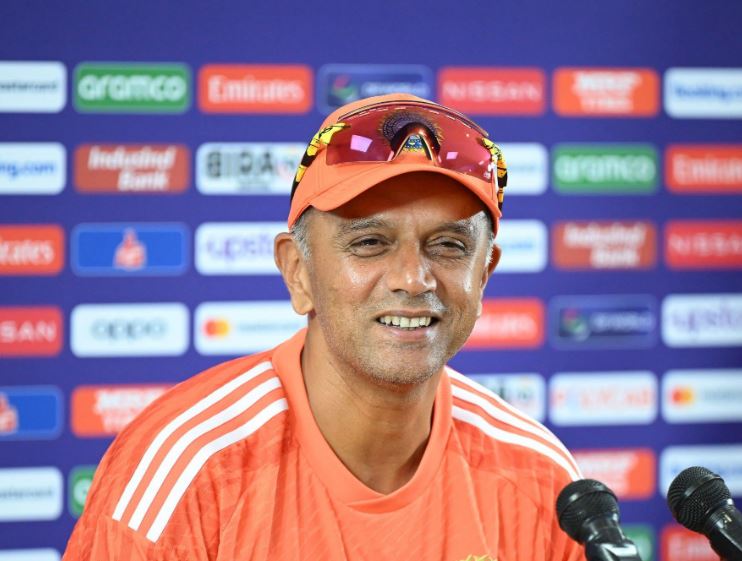Hyderabad: India head coach Rahul Dravid was left rueing over the inability of his team not getting 70-80 runs more in their first innings of the Hyderabad Test which the hosts’ eventually ended up losing by 28 runs to England at the Rajiv Gandhi International Stadium.
In their first innings total of 436, Yashasvi Jaiswal, KL Rahul, and Ravindra Jadeja made 80, 86, and 87 respectively, while captain Rohit Sharma and Shreyas Iyer fell after getting starts. Despite taking a 190-run lead, India squandered that advantage as England vice-captain Ollie Pope scored a sensational 196 to turn the game around in the visitors’ favour.
“I thought we left probably 70 runs on the board in the first innings. In our first innings, when conditions were pretty good to bat in on day two, I thought in the kinds of situations we got ourselves into, some good starts and we didn’t really capitalise.”
“We didn’t get a hundred, we didn’t get somebody getting a really big hundred for us. So, in some ways, in India, I just felt we left those 70, 80 runs back in the hut in the first innings. The second innings is always going to be challenging. It’s one of those things that it’s tough. It’s not easy to chase 230 or it’s not done very often,” said Dravid in the post-match press conference.
India were given the challenge of chasing down 231 on day four, but none of the batters were proactive, nor applied themselves, and fell in tame fashion to be out for 202, with debutant left-arm spinner Tom Hartley taking a superb 7-62. With many batters dismissals in the second innings varying between giving catches to close-in fielders and being trapped lbw, Dravid opined the young Indian batters’ are still learning the craft of playing a long innings in Test cricket.
“A lot of players are quite young, in the sense that a lot of these guys do play a lot of white-ball cricket and also maybe don’t get a lot of time to get to play a lot of first-class cricket as well. So they’re learning and I think they’re getting there. To be fair, there have been challenging wickets as well over the last few years.”
“It’s been a bit of a challenge for some of our young batsmen to adapt. But they’ve got the skill and they’ve got the ability, and they’ve not come here just like that; they’ve come here by scoring a lot of runs in domestic cricket, doing well in A-team cricket. So, they are being picked on merit.”
“Sometimes it does take time for people to adjust. They’re working hard. I will say that, I mean, there’s a lot of thought going into a lot of their batting and for them, it’s just a question of them looking to constantly keep improving and developing skills that maybe help them counter this kind of conditions a little bit better,” he added.
Through his 7-62, Hartley added himself alongside Steve O’Keefe, Ajaz Patel, Michael Clarke, Monty Panesar, and Matthew Kuhnemann in a list of left-arm spinners running through the Indian batting line-up in Tests at home. Dravid signed off by saying there will be a review of India’s batting strategy against left-arm spinners.
“I wouldn’t be so harsh to judge them on today. I wouldn’t say this was a flat wicket by any stretch of the imagination. It turned through the course of the game. It allowed you to score runs. As we saw even in the fourth innings, you could score runs, but it was still challenging.”
“When it gets to these kinds of situations, you have to give credit to the bowlers. They were able to pitch the ball in the right areas, pitch it where it was challenging for us, and spun the ball pretty appreciably.”
“I think using your feet to the left-hand spinner with these kinds of conditions is fraught with risk, probably have to play a little bit more square of the wicket. Having said that, that (reverse-sweep) is a high-risk shot as well. I thought Ollie Pope did that loosely. I mean, he did play a lot of high-risk shots and then it came off.”
“But that’s where I think probably in the first innings we could have capitalised a little bit more. I don’t see it as a huge issue. I think when you have a turning track and you have good left-hand spinner who’s able to pitch it in line with the stumps in just sort of in a difficult area it is going to be a challenge.”
“But as the series goes on, I think it’s going to be something that we’re going to have to counter and get better at and develop some plans and strategies around,” Dravid concluded.
